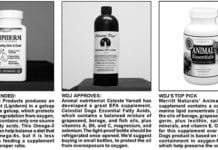Whole Dog Journal’s 1998 Canned Dog Food Review
and disabled." It includes meat that was too high in hormones
Benefits of Vitamin C to Your Dog
For humans, a source of vitamin C in the diet is literally necessary for survival. Early sailors deprived of fresh foods for extended lengths of time often suffered from scurvy
Are Premium Dog Foods Worth It?
Choosing the right food for your dog is an important task, with both short-and long-term consequences. Many veterinarians have come to believe that the best foods for a dog are those that are closest to his ancestral diet: raw meat, in all different cuts and varieties, and a sprinkling of herbal or vegetable matter. But for many of us, providing that kind of diet is inconvenient, time-consuming and expensive. So, for those of us who have gotten used to the ease of feeding dried dog food out of a bag, WDJ can help you become an informed consumer.
The Holistic Dog Food Store
Visit most pet stores especially the large, warehouse-style chain stores and ask for their best" dog food. Chances are good that you will be directed to shelves containing big-name foods that are high-priced
How Many Treats Dogs Should Receive
Opinions vary about how, when, and how many treats dogs should receive, but we’ll leave that to the dog trainers. If getting treats is a regular part of your dog’s routine, whether he gets one or two a day or a whole box each week, your first consideration should be the healthfulness of the treat. Any food that your dog eats regularly – even if it’s in small amounts – should be able to pass the same criteria as his food.
Do Dog Supplements Really Work?
When a specific dietary supplement is given to an individual (canine or human) who previously lacked the nutrients or chemicals offered by the supplement, or whose body required a higher dose than was previously available, miraculous improvements in health, appearance, and attitude can indeed take place. But most people have no idea whether they are lacking something before they add it to their own or their dog’s diet!
A Dog Who Is Always Hungry
We adopted our rescue dog about a year ago. She had been a stray, and at the time we adopted her the vet thought she was about ten months old. Ever since we’ve had her she has had the same symptoms – she doesn’t seem to be able to properly digest her food. She is ravenously hungry all the time. She will eat unlimited amounts of anything – fruits, vegetables, yogurt, bread, anything she can get her paws on. And her stools are not normal; she has about four bowel movements per day, and they get progressively softer throughout the day.
Feeding Your Dog a Raw Diet
For thousands of years, Mother Nature has fed her dogs and cats raw food. Their wild cousins continue to dine on freshly captured prey, but most American dogs and cats eat commercial pet foods from cans and packages or home-cooked grains and meats. The result, say a number of veterinarians and nutritionists, is deteriorating health in our canine companions. In response is a growing trend toward home-prepared diets for our dogs, away from cooked food and toward more natural fare.
Diet Saves the Day
The Whole Dog Journal often contains articles about the benefits of feeding dogs a natural diet for optimum health. I want to share a story about my wire-haired fox terrier, Spike, which portrays the extreme benefits of not only feeding your dog a natural diet, but also of treating your dog holistically. Spike’s experiences before and after we started him on a natural diet (at the age of 10) astounded me, and I hope his story can be a good example for the rest of the Whole Dog Journal readers!
Essential Fatty Acids For Increased Canine Health
Most animal lovers know that dogs need high quality protein, fat, and a complete complement of vitamins and minerals in their diet to remain healthy. We know that the foods our canine companions eat should come from clean, wholesome sources, and that a good diet must be combined with ample exercise and a healthy living environment. But when planning a diet for a companion animal, many of us overlook some very important aspects of what constitutes complete nutrition for an animal.
Change of Dog Food Stops Seizures
On April Fool's Day 1996, my soon-to-be-husband took me to get a puppy. We already had one dog, Ladybird, but she was getting older and we felt a young friend would encourage her to be more playful. We also hoped Ladybird would pass on some of her fine qualities to the puppy. We drove out of town to a place where people play paintball. There were more than a dozen young dogs running around, and the owner told us to take our pick. One young female seemed to want my attention more than any of the others, and I fell in love with her pretty face. We took her home and named her Cheyenne.
Healthy Dog Treats
It’s been a little more than a year since we last examined dog treats, but, oh, what a year! It’s amazing (and fortunate for our dogs) how quickly the “healthy dog foods” consciousness is rising, and how many more healthy treats are available than there were last year. For example, we’re seeing far fewer treats that contain propylene glycol, or artificial preservatives and colors, and far more treats containing nothing but healthy, whole foods. “A rising tide raises all boats,” goes the old saying.


















